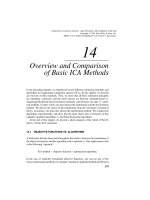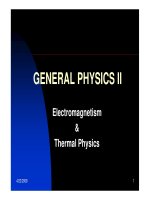Chapter 1 concepts and behavior of gas
Bạn đang xem bản rút gọn của tài liệu. Xem và tải ngay bản đầy đủ của tài liệu tại đây (2.67 MB, 54 trang )
PHYSICAL CHEMISTRY 1
Dr. Ngo Thanh An
1
Introduction
•
The principal goal of physical chemistry is to understand the properties and behaviour of
material systems and to apply this understanding in useful ways.
2
References
Textbook
3
Introduction
Thermodynamics:
phenomenological theory to
describe
equilibrium
properties of macroscopic
systems
based
on
few
macroscopically measureable
quantities.
Or: The study of heat and its
transformation into mechanical
energy
is
called
thermodynamics.
4
Introduction
5
Definitions
6
Definitions
•
•
•
•
Macroscopic system: A large system containing many atoms or molecules
Microscopic system: a system consisting of a single atom or molecule
Macroscopic properties (such as temperature and pressure) apply only to a macroscopic
system and are properties of the whole system.
Microscopic properties (such as kinetic energy and momentum) are mechanical in nature.
7
Definitions
A body or system whose condition
is altered without gaining heat from
or losing heat to the surroundings
(energy is transferred only as work.)
8
Definitions
Thermodynamic definition of work: It is a kind of interaction that would occur at the system boundaries. It can be positive or negative.
Heat: Heat is a mode of energy transfer that takes place between the system and the surroundings solely due to the temperature difference. Thus, heat is a
transient phenomenon. It can be recognized only during a process.
Energy exists in many forms, such as mechanical energy, heat, light, chemical energy, and electrical energy. Energy is the ability to bring about
change or to do work.
9
Definitions
A thermodynamic process is a passage of a
thermodynamic system from an initial state
10
to a final state
Definitions
When a gas is compressed or expanded so that no heat enters or
leaves a system, the process is said to be adiabatic.
Adiabatic changes of volume can be achieved by performing the
process rapidly so that heat has little time to enter or leave or by
thermally insulating a system from its surroundings.
Do work on a pump by pressing
down on the piston and the air is
warmed.
11
Definitions
When a gas adiabatically expands, it does work on its surroundings
and gives up internal energy, and thus becomes cooler.
Blow warm air onto your hand from your wide-open mouth. Now
reduce the opening between your lips so the air expands as you blow.
Adiabatic expansion—the air is cooled.
12
Definitions
A source supplies
energy in the form
of heat, and a sink
absorbs it.
Bodies with relatively large thermal
masses can be modeled as thermal
energy reservoirs.
•
A hypothetical body with a relatively large thermal energy capacity (mass x specific
heat) that can supply or absorb finite amounts of heat without undergoing any
change in temperature is called a thermal energy reservoir, or just a reservoir.
•
In practice, large bodies of water such as oceans, lakes, and rivers as well as the
atmospheric air can be modeled accurately as thermal energy reservoirs because of
their large thermal energy storage capabilities or thermal masses.
13
Definitions
•
State Variables
• system quantity whose values are fixed at constant
temperature, pressure, composition
•
State Function
• a system property whose values depends only on the initial
and final states of the system.
•
Path Functions
• system quantity whose value is dependent on the manner
in which the transformation is carried out.
14
Definitions
An intensive property is a bulk property, meaning that it is a physical property of
a system that does not depend on the system size or the amount of material in
the system. Ex: Temperature, Pressure, density, specific heat, …
By contrast, an extensive property is additive for independent, non-interacting
subsystems. The property is proportional to the amount of material in the system.
Ex: volume, mole number, mass, length, entropy, enthalpy, Gibbs free energy …
State
function
State 1
(x1,y1,z1)
(depending on state
variables)
State 2
(x2,y2,z2)
(depending on state
variables)
• State functions: Can we find the exact form of functions?
We don’t need to know the functions because we just pay
attention to the initial and final state.
• State 1 or state 2 is completely determined by the value of
15
its state functions at a certain set of state variables.
Definitions
State variables:
Describe equilibrium state of thermodynamic system uniquely.
Intensive: homogeneous of degree 0, independent of system size
Extensive: homogeneous of degree 1, proportional to system
size
Note: Intensive state variables serves as equilibrium parameters.
Ex: temperature (T), pressure (P) and chemical potential (µ).
-------------------------------------------Euler's Theorem: Let f(x1,…,xn) be a function such that
f (λ x1 ,..., λ xn ) = λ n f ( x1 ,..., xn )
Then f is said to be a homogeneous function of degree n.
16
Definitions
Intensive and extensive variables
17
Definitions
Definitions
•
•
•
Gas - a substance that is characterised by widely separated molecules in rapid motion
Mixtures of gases are uniform. Gases will expand to fill containers.
Ex:
- Common gases include - O2 and N2, the major components of "air"
- Other common gases - F2, Cl2, H2, He, and N2O (laughing gas)
19
Some state variables
•
•
•
•
The pressure of a gas is best defined as the forces exerted by gas on the walls of the container
Define
P = force/area
The SI unit of pressure is the Pascal
2
2 2
1 Pa = N/m = (kg m/s )/m
Force
Pr essure =
Area
20
Some state variables
21
Some state variables
•
•
•
How do we measure gas pressure?
We use an instrument called the barometer - invented by Torricelli
Gas pressure conversion factors
• 1 atm = 760 mm Hg = 760 torr
• 1 atm = 101.325 kPa = 1.01325 bar
• 1 bar = 1 x 105 Pa (exactly)
22
Some state variables
Definition: Temperature measures the degree of hotness of a body (“how
hot”). It doesn’t depend on the mass or the material of an object. It can be
thought of as a measure of the average kinetic energy of the atoms or
molecules in a body.
23
Some state variables
If two thermodynamic systems are each in thermal equilibrium with a third,
then they are in thermal equilibrium with each other.
24
Some state variables
As thermal motion of atoms increases, temperature increases. There seems to
be no upper limit of temperature but there is a definite limit at the other end of
the temperature scale. If we continually decrease the thermal motion of atoms
in a substance, the temperature will drop.
Absolute zero is the temperature at which no more energy can be extracted
from a substance.
At absolute zero, no further lowering of its temperature is possible. This
temperature is 273 degrees below zero on the Celsius scale. Absolute zero
corresponds to zero degrees on the Kelvin, or thermodynamic, scale and is
written 0 K (short for “zero Kelvin”).
Unlike the Celsius scale, there are no negative numbers on the thermodynamic scale.
Degrees on the Kelvin scale are the same size as those on the Celsius scale. Ice melts at
0°C, or 273 K, and water boils at 100°C, or 373 K.
25









